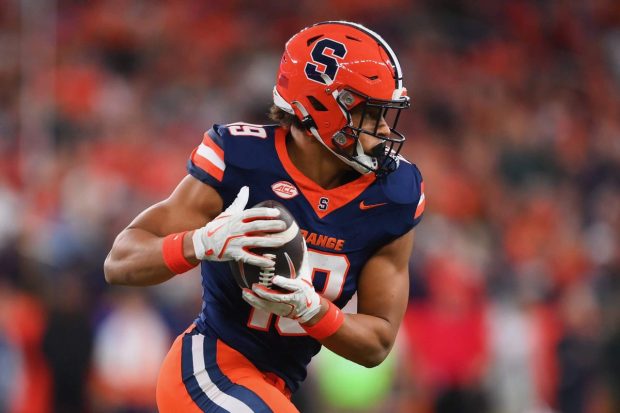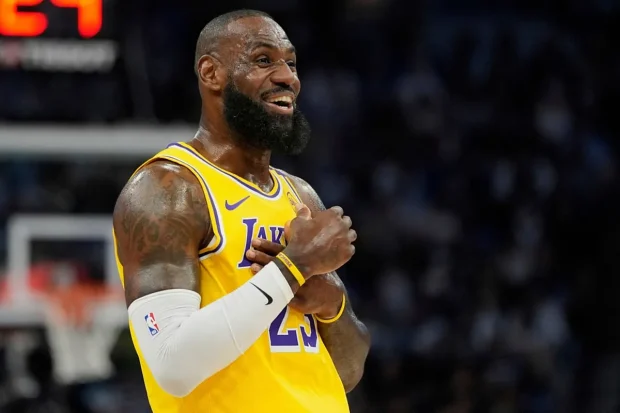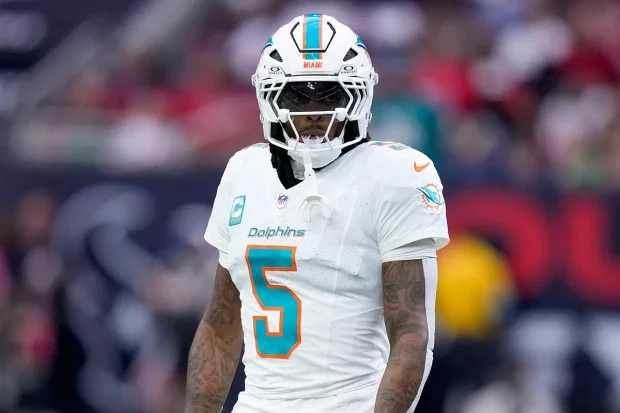

The 2025 NFL Draft is just days away and it’s time to put all of the hours poured into evaluating All-22 college film, analytics and data into a set of tiers and rankings. Of course, it’s vital to note that these rankings will change based on draft capital. Where a running back is selected in his class plays a big role on his future Fantasy Football outlook. However, the data and film tell the clearest story. If you want to find out the rest of my tiers, rankings and individual breakdowns of players, make sure you subscribe to the Fantasy Football Today newsletter. You’ll find everything there. You can subscribe at the link below:
Below, we will reveal my tiers and rankings and then break down the first tier in depth. You’ll find in-depth breakdowns of the prospects in other tiers in the newsletter.
Pre-Draft 2025 RB Rankings
(For Dynasty Fantasy Football purposes)
When we have landing spots and draft capital as part of the equation, I will adjust these rankings. For now, think of these as my best attempt to describe the respective Fantasy appeal for each RB, completely independent of draft capital. Some players will drop dramatically if projected draft capital holds true — namely, Raheim Sanders and Tahj Brooks feel vulnerable to a draft day slide.
When considering how conducive to Fantasy scoring each RB’s skill set is, I do prefer those two running backs to the likes of Kaleb Johnson or Bhayshul Tuten. But projected draft capital strongly favors the latter. How I see it, Brooks and Sanders have more paths available that may lead to Fantasy success, because of their ability to contribute in a variety of ways. Johnson and Tuten have a wide path available to them — become a team’s preferred option on outside zone runs (here’s a look at the teams who may be most-likely to employ an outside zone runner) and a 1A or 1B in an offense’s early-down RB split — but if they stumble along that path, I’m not sure how flexible we can expect either back to be in course-correcting to still carve out a successful NFL career.
Sanders and Brooks may be destined to careers as backups, but there are paths to more that could open up. Both have the size to be a positive contributor in short-yardage situations, and unlike Johnson, both performed well in that regard at the collegiate level. Both have the receiving skill set to add value as a pass-catcher. Brooks even feels like a strong bet to eventually become the best pass-blocker in his RB room. Either could prove to be viable or even exceptional runners of the football as pros, and both offer skill sets that fit well with man or gap blocking schemes.
There’s a lot of nuance to consider when evaluating the RB position and how collegiate production might translate to the pros. I did my best to categorize my view of the RB skill sets in this tweet:
I belabor this introduction with hope that I can get you thinking about these players in a more dynamic way.
A landing spot that might accentuate a skill set could propel any of these running backs into a successful NFL career, but not every team is going to provide that. For players like Johnson or Tuten, there may only be a handful of teams that provide an ideal fit.
Let’s dive into these rankings. At some point, I have to give you a list, even if it pains me to paint this picture in black and white. There will be plenty of time over the next month for me to flesh out the details — here in the newsletter, on X, and across various podcast appearances — please do seek out updates as we get more information on the potential paths facing these RBs as they arrive at the NFL level
Following the conclusion of the 2025 NFL Draft, most teams will have two or even three running backs who could offer high-level production. It’s going to be extremely interesting to watch these backfields sort themselves out. To me, that process begins now.
Tier 1
RB1 — Ashton Jeanty
Tier 2
RB2 — Omarion Hampton
RB3 — TreVeyon Henderson
Tier 3
RB4 — Quinshon Judkins
RB5 — Dylan Sampson
Tier 4
RB6 — Cam Skattebo
RB7 — RJ Harvey
RB8 — DJ Giddens
RB9 — Damien Martinez
RB10 — Tahj Brooks
RB11 — Raheim Sanders
RB12 — Jacory Croskey-Merritt
RB13 — Devin Neal
Tier 5
RB14 — Kaleb Johnson
RB15 — Bhayshul Tuten
(These two will almost assuredly shoot ahead of Brooks, Sanders, and JCM when we see draft capital. I prefer the more varied skill sets of the three that I have in Tier 4, but Johnson and Tuten offer enticing zone rushing upside and are younger)
Tier 6
RB16 — Jarquez Hunter
RB17 — LeQuint Allen
RB18 — Ollie Gordon
RB19 — Brashard Smith
RB20 — Jaydon Blue
RB21 — Corey Kiner (this pains me, I love Kiner, but I can’t rank him ahead of guys with more receiving upside)
RB22 — Kyle Monangai
RB23 — Jordan James
The Kiner ranking was the toughest, but this whole tier was brutal for me to rank. Specifically, Allen and Gordon do not profile as top-20 backs for me in terms of what they are able to do with the ball in their hands. But, when it comes to their ability to contribute as pass protectors, those two are undeniably more-likely to earn NFL playing time than most backs from this class.
Someone like Kiner, Blue, or Smith might be more likely to return huge return on investment, but they’re also more likely to be a wasted roster spot.
Tier 7
RB24 — Trevor Etienne
RB25 — Montrell Johnson Jr.
RB26 — Marcus Yarns
RB27 — Jo’Quavious “Woody” Marks
RB28 — Kylin James
RB29 — Phil Mafah
RB30 — Kalel Mullings
Tier 1
RB1 — Ashton Jeanty, Boise State
21.8 years old at start of 2025 NFL season
Ashton Jeanty checks every box. He’s by far the most efficient and effective RB prospect that I have evaluated. I’ve heard some nitpick that his overall receiving profile is underwhelming, but I’d push back on that notion.
Again, Jeanty laps the field.
Boise State simply chose the most-possible straightforward approach in 2024 — feed Jeanty on the ground, over and over, even if the defense knows it is coming — and he still could not be stopped. That certainly does not mean that he can’t also contribute at a high level as a receiving option.
Barring unforeseen circumstantial occurrences, Jeanty will quickly establish himself as the most valuable Fantasy RB, if his tape and data are any indication. This is the most rare profile that I have ever evaluated at any position. Any opportunity to trade up for the 1.01 in Dynasty rookie drafts is worth exploring, in my opinion.
Tier 2 — Omarion Hampton and TreVeyon Henderson
USATSI
RB2 — Omarion Hampton, North Carolina
22.4 years old at start of 2025 NFL season
Hampton and Henderson belong in a tier of their own, by my estimation, because of their ability to contribute as pass protectors. This opens up the possibility of sole possession of a backfield. If able to earn a coaching staff’s trust as a primary third-down option, either back could log a snap rate above 70% in the right landing spot. That’s basically a ticket to top-10 Fantasy RB production.
If looking for a red flag from Hampton’s profile, this note that I found when digging into RB splits vs. Power-4 and non-Power-4 defense might just be it. In fact, both Hampton and Henderson boosted their collegiate efficiency metrics in a big way when facing non Power-4 defense. Hampton’s splits vs. Power-4 defense were straight up underwhelming.
Omarion Hampton’s rushing EPA per 100 snaps:
+35.3 — Non P4
-0.6 — P4
Omarion Hampton’s rushing success rate:
55.9% — Non P4
41.8% — P4
Omarion Hampton’s yards per rush:
7.6 — Non P4
5.1 — P4
Especially given that Hampton faced ACC competition that isn’t considered in the same tier as some other Power-4 conferences (namely, the SEC where Dylan Sampson played or the Big-10 where Henderson and Judkins played), this note stands out.
The average dip in rushing efficiency vs. Power-4 competition is 15-20%, Hampton’s was in the 25-35% range. That’s notable. It does not negate his overall awesome profile, though. We could pick similar nits with Ashton Jeanty’s level of competition. The skills still showed up for Jeanty, though. And the same is true, to a lesser extent, for Hampton.
I loved Hampton’s film. I see his vision, appreciate his patience, and love the way he uses tempo as a runner to set up blocks. He can win in a variety of ways. He’s adept at creating something from nothing, was often hit at or behind the line of scrimmage, and consistently churned out excellent yardage after contact. He has an uncanny ability to get skinny passing through the line of scrimmage and is a load to bring down once he accesses the second level. He can play on all three downs. He may be staring at 20 touches per game as a rookie with Round 1 draft capital attached to his name. I wouldn’t overthink this profile when it comes to drafting for Fantasy purposes. I also wouldn’t get carried away with projecting him to join the elite tier of NFL running backs before we see how his game translates to the NFL level. I am comfortable doing that for Jeanty, because even a significant decrease in his rushing efficiency metrics would still result in league-best rates. He’s that far above and beyond the rest of the pack. Hampton is not.
RB3 — TreVeyon Henderson, Ohio State
22.9 years old at start of 2025 NFL season
Henderson isn’t even near the top of the pack, when it comes to efficiency metrics, and he’s actually near the bottom when it comes to market share numbers. So why am I attributing every-down potential to him?
Well, he has shown to possess just that. Henderson logged a snap rate above 70% in 10 games prior to Ohio State emulating the Jahmyr Gibbs-David Montgomery approach in 2024, and he handled that workload well. Henderson averaged 22.6 touches and 128 scrimmage yards in those games. Three of those games came as a true freshman at Ohio State, and Henderson logged 22, 27, and 29 touches across those games.
There are nits to pick with Henderson’s profile. But he makes up for them. This play encapsulates Henderson’s profile perfectly — his vision can be inconsistent, but his overall ability is so overwhelmingly good that it often makes up for it. I have no concerns about Henderson as a rusher, even though his vision and tackle-avoidance both lack creativity.
The one nit that I will pick is with his receiving production. He never accounted for more than seven percent of his offense’s receiving yardage market share. Henderson’s per-route receiving production comes nowhere near sniffing Jahmyr Gibbs or other elite dual threats at RB. Judkins had a higher first down per route run rate than Henderson while sharing a backfield, and their yard per route run rates were nearly identical. I feel like the narrative that Henderson offers elite receiving upside is irresponsible. In the right situation, if Henderson lands with a creative offensive designer, sure, he could catch and run his way to lots of receiving Fantasy goodness.
Like Hampton, Henderson presents a profile that feels very safe. And there is upside for him to develop into a perennial top-five Fantasy RB with the right circumstances. I would not presume that his skill set will immediately put him into that category, though.
This news was originally published on this post .











Be the first to leave a comment